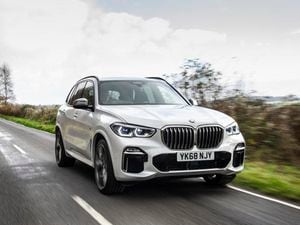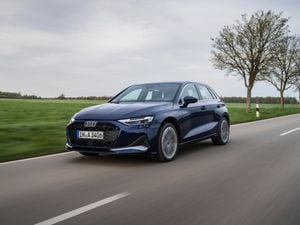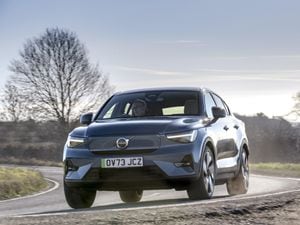First drive: The BMW X5 is a great all-rounder against talented competition
How does the new BMW X5 fare in a hotly-contested segment? Tom Wiltshire finds out

What is it?
Some charge BMW with creating the craze for premium SUVs with the original X5 and X3. These were cars that looked every bit the rugged off-roader, but traded in any ability on the rough stuff in favour of being fabulous to drive on tarmac.
With the new X5, the brand’s engineered some off-road ability back in, and hopes to combine it with its well-loved on-road manners as well as a serious dose of luxury to create a car that can – theoretically – do anything. But the high-end SUV market has some brilliant entrants in that BMW has to match – the archetypal Range Rover Sport, the luxurious Mercedes GLE and the tech-filled Audi Q7 to name but a few. Not forgetting that the X5 will soon no longer be the brand’s flagship SUV, as the monstrous X7 launches next year. A tough gig, then.

What’s new?
The X5 has switched onto the same modular underpinnings as its smaller sibling, the X3 and X4, giving it access to a whole range of new tech. For the UK, there’s standard air suspension, as well as active four-wheel steering to help make the massive X5 feel more agile.
There’s plenty of tech inherited from other models, such as the new standard digital gauge cluster and widescreen infotainment system – renamed from the classic ‘iDrive’ to the rather bland ‘BMW Operating System 7.’ On the styling front, there’s the latest iteration of BMW’s kidney grilles, now joined in the middle by a chrome bar, as well as optional Laser LED headlights and wheels of up to 22 inches – available even on base models.
What’s under the bonnet?
Three engines are coming to the UK initially – all 3.0-litre straight-six turbocharged units. For petrol lovers (or diesel despisers) there’s the 40i petrol, which produces 335bhp and 450Nm of torque and is capable of 0-60mph in less than 5.5 seconds. Official fuel economy of just 33.2mpg and CO2 emissions of 193g/km should see it remain a relatively niche choice, though BMW’s anticipating more customers will opt for it as diesel’s popularity continues to wane.
The vast majority of buyers will opt for the 30d diesel – a twin-turbo unit, producing 261bhp and a hefty 620Nm of torque. It’s a good engine, too – creamy smooth and relatively powerful, though it struggles a little with the X5’s 2.2-tonne bulk when overtaking. BMW’s also synthesised a fake engine noise, which is a little too loud and distracting – though at a cruise, near-silence reigns in the cabin. Official fuel economy of 47.1mpg isn’t too shabby either.
The top end is rounded off with the M50d, which turns the X5 into an absolute weapon. It’s ferociously powerful, without too much drama from a standstill but a heroic chunk of mid-range torque – 760Nm of it, in fact. Power output is 395bhp, while combined MPG stands at 41.5, though that will definitely take a tumble if you intend on using the accelerator with the alacrity it demands. All three engines are mated to the same rear-biased xDrive four-wheel drive system and BMW’s fantastic eight-speed automatic gearbox.

What’s it like to drive?
The X5 has a reputation for its ability on the tarmac, and that’s been replicated in this new model. What’s impressive is how small this 2.2-tonne behemoth feels on the road – it doesn’t feel as though it’s fighting its weight in the corners, and it stays impressively flat and level.
The rear-wheel steering helps with this agility, though some won’t like the way it feels – almost as though the rear of the car were squirming under load. Once you’re used to it, though, it feels natural. The X5 won’t trouble the likes of a Porsche Cayenne on the tarmac, but does make a Range Rover Sport feel heavy and leaden.
The ride has the floaty hallmarks of air suspension, but ride quality is a little compromised by the 22-inch wheels it’s possible to specify on even the entry-level model. Smaller options are available, and we suspect this would take the brittle edge off matters, even if they don’t look as good.
BMW’s rear-biased xDrive system is capable of sending all of the power to the front wheels if necessary, and it combines with an optional xOffroad package to make this new X5 far better on the rough stuff than its predecessor. It won’t trouble a Range Rover Sport, but it’s fair to say that most X5 owners won’t be aiming to rock-crawl or do any serious mud-plugging. Around the woods of the Goodwood estate, it never felt troubled.

How does it look?
BMW’s latest corporate design is divisive to say the least, and the X5 takes some of its cues from the massive – and, if we’re honest, fairly ugly – X7. That means a vast chrome grille, joined in the middle unlike BMWs of old, and sharp lines throughout. It’s certainly distinctive, however, and once you get past the snout the rest of the car looks decent.
The front features slim LED headlights with a new hexagonal motif flank that walloping conk, while round the rear, LED taillights help the X5 feel even wider than it is. Not that it needs to be, as it’s already 56mm wider than its predecessor, as well as 36mm longer and 19mm taller.
The wheel designs in particular – other than the entry-level 19-inch units – are great, and the X5 looks properly mean on 21- or 22-inch rims. Round the back though, it’s pure X3 – a little bland and a little anonymous.

What’s it like inside?
The X5’s interior is supremely spacious and the seats – both front and back – are excellent. There’s a vast range of adjustment to the driving position, allowing anyone to get comfortable, and the 650-litre boot can be extended to 1,870 litres with the seats folded down. An optional third row secures this as a luxury SUV that would suit large families, too.
Our beef is with some of the redesigned elements, which feel like a step backwards compared to the previous model. Take the gauges, for example – they’re now fully digital, which is very slick and modern, but their angular half-octagonal shape affords nothing like the clarity of the brand’s signature twin circular dials.
There are other annoyances – such as the hard-to-read climate controls, as well as the cheap-feeling materials on the central tunnel. It’s a shame that some of the fundamentals, items BMW’s been getting bang-on for the last couple of decades, should be abandoned in the pursuit of showing off.

What’s the spec like?
Equipment’s generous, as you’d hope for the X5’s £57,495 asking price. LED headlights, leather upholstery, electric and heated front seats, air suspension, all-round parking sensors and a reversing camera, multi-zone climate control, adaptive cruise control, emergency braking and a range of online services.
The majority of customers will opt for the M Sport package, netting meaner-looking body styling and standard 20-inch wheels, and some models even get a crystal-glass gearknob and infotainment controller.
However, we can’t help but find the addition of Apple Carplay as a cost option very stingy. Worse still, it’s on a yearly subscription – so if you want to keep your phone connected, you’ll have to pay up. That’s a real blow, considering many superminis offer it as standard, and often throw Android Auto in as a bonus – yet the latter isn’t even an option on BMW models.

Verdict
The BMW X5 falls down in too many areas to call it a definite class-leader, but the attraction will be there for many – it’s still a status symbol, it’s still eye-catching and it’s still great to drive. The additional capability afforded by some genuine off-road chops will broaden its appeal, too, and we’re looking forward to trying 2019’s plug-in hybrid model. It’s a good all-rounder with only a few negatives – and in this competitive sector, that’s all you can ask for.





